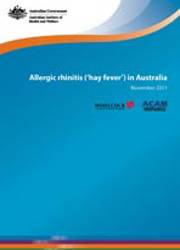Summary
Hay fever is a common term referring to allergic rhinitis caused by seasonal exposure to pollen. Allergic rhinitis is a runny or blocked nose and/or sneezing and watery eyes, and is triggered by an allergic reaction. Allergic rhinitis can have many triggers and can occur seasonally or throughout the year.
Allergic rhinitis is one of the most common chronic respiratory conditions in Australia. Unlike many health conditions, allergic rhinitis is more common in those of working age than it is in the young and the elderly.
Allergic rhinitis can cause significant irritation and interference in a sufferer’s daily activities, considerably reducing the quality of life.
Causes and exacerbating factors
The symptoms of allergic rhinitis are caused by an allergic reaction in the inner linings of the nose.
Common triggers of allergic rhinitis come from house dust, animal fur, pollens, fungal spores, air pollutants and occupational sources.
Prevalence
Based on self-reports from the 2007–08 National Health Survey, allergic rhinitis affects around 15% of the Australian population, or about 3.1 million people.
It is more commonly reported by females than males.
It is most commonly reported by those aged 25–44 years, and least commonly by those in the 0–14 and 65–74 year age groups.
The Australian Capital Territory and Western Australia have the highest rates of allergic rhinitis in Australia, and Queensland and New South Wales have the lowest.
Use of medications
The main medications used in the treatment of allergic rhinitis are intranasal corticosteroids (nasal sprays) and oral antihistamines.
According to IMS Health wholesale data, the amount of money paid by community pharmacies to wholesalers for these medications doubled between 2001 ($107.8 million) and 2010 ($226.8 million). Although not all of these medications would have been used for allergic rhinitis, it is likely to have accounted for a large proportion of this increase.
Management in hospital
Allergic rhinitis is not a common cause of hospitalisation. In 2008–09, hospitalisations for allergic rhinitis (as a principal diagnosis or additional diagnosis) represented around 0.02% of all hospitalisations.
Males are more likely to be hospitalised for allergic rhinitis than females, and children are more likely to be hospitalised than adults.
Other conditions that commonly occur together with allergic rhinitis
Conditions that commonly occur alongside allergic rhinitis include asthma, chronic sinusitis, otitis media (middle ear infection) and decreased quality of sleep.
Preliminary material: Acknowledgments; Abbreviations
1 Introduction
- Relationship to other conditions
- Structure of report
2 What causes and worsens allergic rhinitis?
- Genetic factors
- Age
- Early life factors
- Allergen exposure
- Pollutants
- Occupational exposures
3 Who has allergic rhinitis?
- Age and sex
- Geography
- Country of birth
4 How is allergic rhinitis managed?
- Use of medications for management of allergic rhinitis
- Management of allergic rhinitis in general practice
- Management of allergic rhinitis in hospital
Discussion
Appendix A: Definitions and data sources for medication data
End matter: Glossary; References



